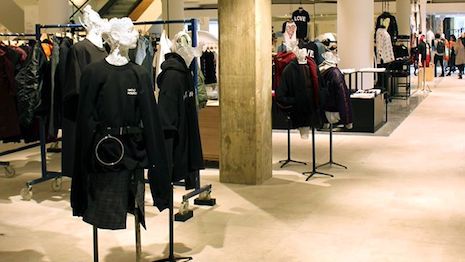- About
- Subscribe Now
- New York,
October 24, 2017

 Selfridges' Designer Studio. Image credit: Selfridges
Selfridges' Designer Studio. Image credit: Selfridges
Technology's growth is pushing many industries toward automation, but a new study from the Council of Fashion Designers of America and global courier service DHL is proving that human input is vital for the design process.
The CFDA’s “Human-Centered Supply Chain delivered by DHL” report explained that the industry of fashion design and production is vastly different. To stay afloat in the current climate, designers need to have an organized process with distinct communication to streamline flexibility.
“The CFDA is always looking to provide its members with new ways of looking at their businesses in this rapidly evolving fashion industry,” said Mark Beckham, vice president of marketing of the CFDA. “Through our partnership, we are able to leverage supply chain and international expertise to deliver this groundbreaking thought-leadership study around an often overlooked but critical link to success in our industry.”
Evolution of retail
It is vital for brands to create a product with the utmost quality since consumers have more options than ever. Two-thirds of consumers look at much more choices in regards to retail and brands compared to 10 years ago.
 Many consumers feel that brands are doing a poor job of relating to them personally. Image credit: YouGov
Many consumers feel that brands are doing a poor job of relating to them personally. Image credit: YouGov
While technology is increasing automation in production in various industries, it also gives way for faster and seamless knowledge transfer and collaboration across industries.
Technologies likely to have the biggest impact are IoT, driverless vehicles, drones, robotics and artificial intelligence. These technologies have a large influence on labor with the ability to drive efficiency.
Convenience is proving to be a major factor in decision-making for consumers. They are now looking for speed and choice when it comes to deciding on what and where to buy.
One-click purchasing is one of the major growing trends making an impact on convenience.
Buyers are also looking for options and help with informed decision-making. Therefore, brands that leverage recommendations and expert advice can win out.
 Understanding consumer behavior at the neural level will create better ads. Image credit: Farfetch
Understanding consumer behavior at the neural level will create better ads. Image credit: Farfetch
Customization is another influential driver in the retail industry, with consumers having more control than ever. They now come to expect a highly tailored experience that gives them complete control.
Transparency is huge as well, by allowing consumers a look into production and operation conditions.
Luxury is being impacted severely by consumers growing interest in sharing or renting products rather than owning. There is a wider range of service that allows for one-time use and peer-to-peer sharing.
Additional research
As retail moves beyond the traditional store and ecommerce outlet, brands need to use every digital tool available to meet consumers' high standards for customer service.
In Astound Commerce’s Brand Mystery Shopping Study for 2017, the research showed that retailers are moving beyond simple call centers and other customer service options into more engaging and mobile-friendly channels such as live-chat and communicating with customers through social media. This is important given that 54 percent of consumers expect more comprehensive information and 50 percent expect better prices from a brand manufacturer Web site as opposed to a multi-brand retailer (see more).
Thanks to increased connectedness, the traditional barriers between work, play and relaxation have blurred, causing marketers to struggle to develop impactful strategies.
In Amati & Associates’ white paper “Premium Beyond Digital,” the consulting firm examined how technology such as smartphones and innovations in digital media have caused consumption and consumer behavior to evolve. For luxury, this transformation has transitioned from a sector of material possessions to one of “quality time, own space and immersive experiences,” with digital on course to disrupt the luxury goods industry at the product level (see more).
“Today’s fashion designers know the frustrations and challenges that occur between the planning of a new design and its ultimate delivery to retailers and consumers,” said Greg Hewitt, CEO of DHL Express U.S. “Along the way there are communication failures; delays and changes with source materials; manufacturing problems; and changing distribution requirements.
"The idea behind the new supply chain is not just to overcome these challenges, but to eliminate them altogether, using technology and new shipping and logistics tools to streamline the process," he said.
Share your thoughts. Click here